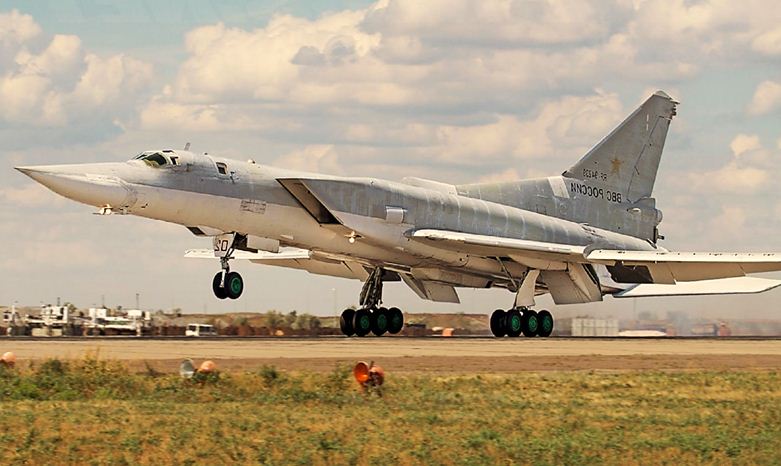According to sources, a Ukrainian drone strike killed Russia’s flagship Tupolev Tu-22 long-range bomber. Images from social media and reviewed by BBC Verify show a Tupolev Tu-22 on fire at the Soltsy-2 airport south of St Petersburg.
According to Moscow, a drone was hit by small-arms fire but managed to “damage” a jet. Ukraine has not responded.
Russia has deployed the Russian Tu-22, which can travel at twice the speed of sound, extensively to target cities in Ukraine. According to the Russian Ministry of Defence, an attack by a “copter-type UAV” occurred on Saturday about 10:00 Moscow time (08:00 BST).
It reported that Soltsy-2 is located at “a military airfield in the Novgorod region.”
“The UAV was detected by the airfield’s observation outpost and was hit with small-arms fire,” according to the government.
“One aeroplane was damaged; there were no casualties as a result of the terrorist act.” According to the statement, a fire that broke out in the airfield parking lot was immediately doused.
Images provided on the social media site Telegram, on the other hand, showed a massive fire consuming a plane with the Tu-22’s distinctive nose cone. BBC Verify examined the photographs and determined that they were credible.
While the loss of a single aircraft has limited impact on Moscow’s existing 60-strong fleet, the operation demonstrates Kyiv’s growing capacity to strike targets deep within Russian territory.
In recent months, Kyiv has sent scores of fixed-wing unmanned aircraft to attack Moscow, a voyage of hundreds of kilometres. Soltsy-2 is around 400 miles (650 km) from the Ukrainian border.
The Russian Ministry of Defense’s description of the drone as a “copter-type UAV” suggests a low-cost, commercially available instrument launched at short range.
The Tu-22 is a swing-wing supersonic bomber from the Cold War era, dubbed “Backfire” by NATO and widely deployed in strikes on Ukrainian cities.
Modern versions, such the Tu-22M3, can reach Mach 2 (2,300km/h or 1,430mp/h) and carry up to 24,000kg of weaponry, like as “dumb bombs” and homing missiles.
They were employed in battles in Syria, Chechnya, Georgia, and, most recently, Ukraine.
According to prosecutors in Kyiv, 30 people died in January when a Tu-22-launched missile hit a block of flats in Dnipro.
According to them, the strike was carried out by Russia’s 52nd Guards Bomber Aviation Regiment. The regiment is stationed in Soltsy-2.
By comparing visual indications, such as the appearance of aircraft and bays, to historical satellite photographs of the airfield, BBC Verify identified the site of the Ukrainian drone strike on Soltsy-2.
The images, as well as other witness photos of the occurrence, matched the weather conditions at the time, which were rainy and cloudy.
The aeroplane remnants observed in the footage are consistent with a Tu-22M3.
Historical satellite imagery examined by BBC Verify reveals that such aircraft were stationed at the site.
A representative for Ukraine’s army intelligence service said on Monday that a drone attack in Russia’s Kaluga region had destroyed another military aircraft. Russian media confirmed the incident as well, but denied any damage had occurred.
The Russian Tu-22M3 Bomber
The Tupolev Tu-22, also known by its NATO reporting name “Blinder,” is a Soviet and later Russian long-range strategic and maritime strike bomber. It was designed by the Tupolev Design Bureau during the Cold War era to fulfill the role of a supersonic strategic bomber. The aircraft has undergone several iterations and modifications over the years. Here are some key details about the Tupolev Tu-22:
Origin and Development: The Tu-22 was developed by the Soviet Union in the 1950s as a response to the growing need for a supersonic strategic bomber capable of carrying a significant payload over long distances.
Design and Features: The Tu-22 features a delta-wing configuration, which provides it with the ability to achieve supersonic speeds. The aircraft was powered by turbojet engines and was capable of flying at speeds exceeding Mach 2. Its design allowed it to carry a range of ordnance, including nuclear and conventional bombs.
Variants: The Tu-22 underwent several design changes and variations over its operational history. Some notable variants include the Tu-22B, Tu-22K, Tu-22M (Backfire), and Tu-22M3. The Tu-22M, also known as the Backfire, is an extensively modernized version and remains in service with the Russian Air Force to this day.
Role and Capabilities: The primary role of the Tu-22 was to serve as a long-range strategic bomber capable of delivering nuclear or conventional payloads deep into enemy territory. It was also used for maritime reconnaissance and anti-ship strike missions, with specialized variants equipped for such roles.
Operational History: The Tu-22 series of aircraft saw service in various conflicts and tensions during the Cold War. Its ability to carry both nuclear and conventional payloads made it a versatile asset for the Soviet Union’s strategic capabilities.
Challenges and Limitations: The Tu-22 faced challenges related to its high maintenance requirements, limited range, and vulnerability to modern air defense systems due to its design characteristics. Its relatively short operational range compared to other strategic bombers like the Tu-95 and the later Tu-160 affected its effectiveness in some scenarios.
Modernization: The Tu-22M3 variant underwent substantial upgrades to extend its operational life and enhance its capabilities. These upgrades included improved avionics, increased range, and the ability to carry modern precision-guided munitions.
Current Status: While the original Tu-22 variants have largely been retired from active service, the Tu-22M3 remains operational in the Russian Aerospace Forces as a part of their strategic bomber fleet. It continues to be used for various roles, including conventional strike missions and maritime operations.
Overall, the Tupolev Tu-22 represents an important chapter in the history of Soviet and Russian strategic aviation, showcasing the nation’s pursuit of advanced aviation technology during the Cold War and beyond.







